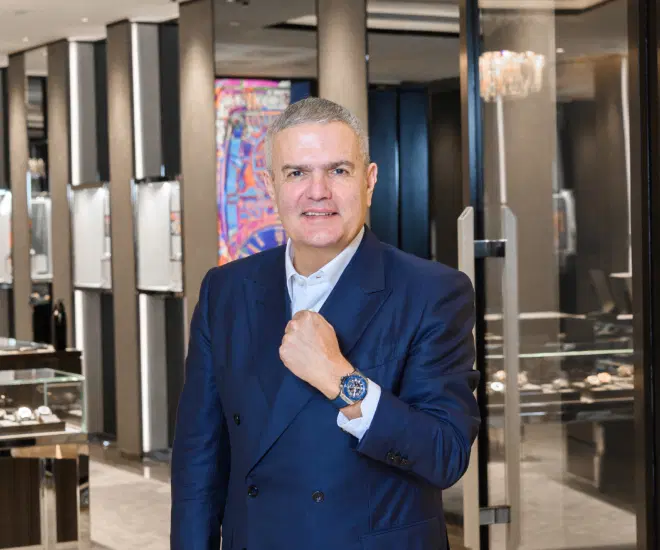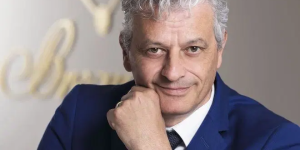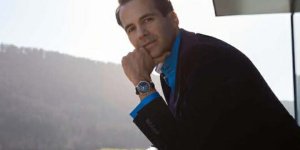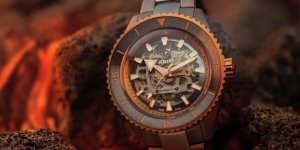Hublot CEO Ricardo Guadalupe On the Brand Being a Trend Maker
Hublot CEO Ricardo Guadalupe takes us through the art of fusion, and how clever marketing can build a bright future for traditional watchmaking.

The contemporary marketing machine that powers Swiss fine watchmaking is, arguably, inextricably linked with the story of Hublot. Famously, the brand emerged from what was then a shocking idea: what if you combined gold with rubber in a luxury timepiece? Such watches are everywhere these days, from the most storied watchmakers to independents working with a completely classical mien. This fact alone was not enough to turn Hublot into the powerhouse it is today, with approximately 60,000 watches produced annually; the brand is one of the most prominent faces of Swiss watchmaking today, what with it being the official timekeeper of the FIFA World Cup, which you cannot have missed, even if you are not interested in the football (and call it soccer).
While all watch collectors associate Hublot with its former boss, the magnetic Jean-Claude Biver, its success is the result of the work of an entire team, one of whom is the current CEO Ricardo Guadalupe. Enticed by Biver to join him at Hublot in 2004, Guadalupe has been at the brand for all its hits, including the explosive trendsetter that was the Big Bang in 2005 and the controversial marketing campaign featuring former F1 supremo Bernie Ecclestone in 2010. That last one was about a literal hit, and correctly predicted a startling growth in criminals targeting the watch collectors in Europe.

Trends were a big deal for Hublot under Biver, who still urges watchmaking brands to seize the opportunity with unoccupied niches, or special offerings. Since Guadalupe took on the top job in 2012, Hublot has largely stayed the course, enshrining its forward-thinking approach in its own brand identity. “Hublot, in order to succeed, had to be different compared to other traditional brands,” Guadalupe told Gulf Business in 2021. “Why else would someone buy a classic Hublot from a 40-year-old brand when they can have beautiful watches from brands that have been in existence for over 100 years?”
We caught up with Guadalupe when he was in town a couple of months ago for the launch of the Hublot boutique in ION Orchard.
Before getting into the story of Hublot itself, you became CEO a little more than 10 years ago. How did you handle the challenge of stepping out of the shadow of Jean-Claude Biver? Arguably, his reputation continues to loom over the brand itself.

In fact, I was already in the brand since 2004, so (I know Mr Biver’s style)… and I was part of the brand’s success even before I took over (as CEO) in 2012. Of course, I am different from Mr Biver, who was very closely linked to Hublot (as a larger-than-life personality) and my priority when I took over was to have the brand stand on its own. The big challenge was to make the brand bigger and more important than any one person, and we achieved that. Today, Hublot alone is an important brand in the watch industry. What I want is for Hublot to stand on its own merits when, one day, I leave the brand.
Hublot was founded slightly more than 40 years ago, in 1980. What are some principles or values that Hublot continues to emphasise?
Hublot represents the Art of Fusion in watchmaking, and the brand did it in 1980 for the first time. It came up with a watch made of yellow gold (a traditional luxury material) with a rubber strap, which is a modern material. This fusion is what we call the Art of Fusion, linking tradition with innovation.
What phase do you think Hublot is at with its “Art of Fusion” motto?

We work on three pillars, and we can bring fusion into design. The Murakami watch, for instance, is a fusion of the art of Murakami and the Hublot art, and we realise a watch that becomes a work of art.
I think consumers are waiting for this kind of product because a mechanical watch today is not important for telling time. It’s important for what it represents, the object (and attendant emotions) it represents.
When it comes to materials, we always try to be innovative. We have coloured ceramics such as red and yellow. We industrialised sapphire crystal in 2016, and we are the only brand to have coloured sapphire, and produce sapphire crystal watches at a certain price point, even though they are expensive. We work on different alloys too (including Magic Gold and King Gold).
And from the movement side, we created the Unico chronograph calibre, various special calibres, and our tourbillon. We are creating new calibres for the future, but it takes years of development, and not months. We try at every level to be innovative.
That’s the key element for the success of Hublot in the future.
- READ MORE: Football Fever: Hublot Loves Football Pop-Up
Speaking of the future, we are seeing unprecedented demand for fine watches. Do you think it really is unprecedented, and how is Hublot coping?
Yeah, it’s true, demand is really high and I’ve never seen that in my career. I think what I have done in the last 10 years at Hublot (sort of anticipating this moment in history) is building a manufacture, an integrated manufacture, being able to produce ourselves, not everything, but parts of the production of movements and in material innovation as well. This allows us to have quite good flexibility in production…of course (this does not mean) we can double our production like this [snaps his fingers]. I think we can manage to grow (and keep up with demand) with the investments we have made in our own industrial capacity.
We have also built strong relationships with our suppliers; we form an important part of their business. This is useful because when you are important to a supplier, you can ask for more and maybe they allocate more for you than other brands. Of course, we share suppliers with a number of brands… Being loyal to our suppliers over a number of years is also important to us, especially during the Covid lockdowns because many suppliers had a tough time, and had to fire staff… we tried to support as much as we could.
How does Hublot optimise its product strategy with the ever-changing taste of consumers?

We try to be innovative and creative and invest a lot in R&D in materials, movements (and in mechanics), and design. These are the three main pillars on which we work.
We try to create trends, and with our innovations and creativity, we can please the existing consumer and new consumers coming in with what we can offer. The key element is always to be innovative, and we do it more by instinct. We don’t analyse other trends; we create the trend.
How has Hublot’s presence in football helped the manufacture reach its marketing goals?
We entered football in 2006 with a very small partnership, and then in 2008, we had the Euro cup in Switzerland. And Mr Biver, at that time, thought about which sport we could support as a partner to communicate about our brand.
If you look at tennis, it’s quite complicated; if you look at golf, it’s complicated. And for football, there is no watch brand. Football is a very popular sport; it talks to not only our potential consumers but billions of people. Football has brought us brand awareness.
When I started working at Hublot in 2004, people in Switzerland didn’t know about Hublot. Today we can say that, in general, people know Hublot is a watch brand. And thanks to football, it was an accelerator for brand awareness, especially with the Hublot Big Bang Unico-shaped Referee Board that we had in Brazil.
Billions of people have seen it, so it is very positive for us and allowed us to be a strong brand in the world thanks to football.
Hublot ambassador Kylian Mbappé is currently one of football’s biggest stars. What do you admire most about him?

To take an active player was a decision. When you have an active player, you can have good and sometimes negative parts, such as injuries or issues in his private life. When you have a legend like the late Pelé, he will remain a legend forever. But at a certain point, I saw this link between a legend and an active player, and I saw it through Kylian Mbappé. Even Pelé sees him as (a successor of sorts) because he won the World Cup at a very young age as Pelé did; they have similar looks and playing styles.
Mbappé accepted to be our ambassador; I think he’s a great personality, very positive. He has values of being serious and passionate, and he has success, so that’s important.
Ambassadorship is one of the main pillars of Hublot’s marketing strategy. What are some values that Hublot looks out for in potential ambassadors?
First of all, we need to have good alchemy in human relationships. An ambassador has to like our brand and not just do a commercial deal. So we always have dinner or spend a moment with the ambassador before signing anything. Of course, they have to carry the values of passion, having success and being aspirational to the young generation.







